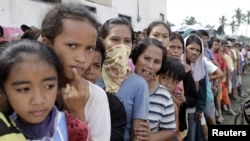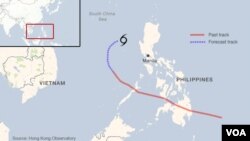Philippine President Benigno Aquino flew to the southern island of Mindanao Friday, to survey the damage left in the wake of Typhoon Bopha, which killed around 500 people and left nearly that many missing.
As stunned survivors searched for missing family members, Aquino met with some of the more than 306,000 people left homeless.
In the town of New Bataan, which was nearly leveled by Bopha, Aquino told the dazed residents that the government wants to find out what happened and how to prevent it from happening again.
Many areas are still inaccessible because of washed-out roads, destroyed bridges and power outages from the storm, which brought powerful winds and heavy rains to the area beginning Tuesday.
The U.S. State Department has offered disaster aid and extended its condolences for the destruction and loss of life.
By Thursday, the storm had moved west of the Philippines into the South China Sea, where forecasters say it could eventually take aim at Vietnam or China.
The worst-hit area was the gold-mining province of Compostela Valley, a mountainous region where mudslides and flash floods washed away two emergency shelters and a military camp.
In nearby Davao Oriental province, which lies along the coast, dozens more people died from flash floods and flying debris as the powerful storm made landfall Tuesday. Officials say in some towns, few structures were left standing.
President Aquino says the government is investigating why an evacuation center and military camp were apparently located in flood-prone areas.
But officials say the government was better prepared to deal with Bopha than with Tropical Storm Washi, which killed about 1,200 people in the southern island of Mindanao last year.
As stunned survivors searched for missing family members, Aquino met with some of the more than 306,000 people left homeless.
In the town of New Bataan, which was nearly leveled by Bopha, Aquino told the dazed residents that the government wants to find out what happened and how to prevent it from happening again.
Many areas are still inaccessible because of washed-out roads, destroyed bridges and power outages from the storm, which brought powerful winds and heavy rains to the area beginning Tuesday.
The U.S. State Department has offered disaster aid and extended its condolences for the destruction and loss of life.
By Thursday, the storm had moved west of the Philippines into the South China Sea, where forecasters say it could eventually take aim at Vietnam or China.
The worst-hit area was the gold-mining province of Compostela Valley, a mountainous region where mudslides and flash floods washed away two emergency shelters and a military camp.
In nearby Davao Oriental province, which lies along the coast, dozens more people died from flash floods and flying debris as the powerful storm made landfall Tuesday. Officials say in some towns, few structures were left standing.
President Aquino says the government is investigating why an evacuation center and military camp were apparently located in flood-prone areas.
But officials say the government was better prepared to deal with Bopha than with Tropical Storm Washi, which killed about 1,200 people in the southern island of Mindanao last year.










